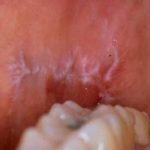
Oral lichen planus (OLP) is a common, chronic, inflammatory, mucocutaneous disorder associated with cell-mediated immune system dysfunction. Clinically a number of forms are classified, reticular, papular, plaque-like, erosive, atrophic, and bullous. A range of therapeutic approaches are used with steroids typically being a first line treatment. Low-level laser therapy (LLLT) is considered to have biostimulatory, anti-infective, and anti-ablation effects and has been proposed as a potential alternative treatment
The aim of this review was to compare the efficacy of LLLT, with corticosteroid therapy, in the treatment of oral lichen planus (OLP).
Methods
Searches were conducted in the Medline/PubMed, Embase, ISI Web of Knowledge, Science direct, SCOPUS, Cochrane Central Register of Controlled Trials, and Cochrane Oral Health Group Trials Register databases. Randomized control trials (RCTs), non-RCTs, controlled or comparative clinical trials (CCTs), including split-mouth clinical trials conducted on adults with clinically and/or histologically diagnosed OLP of more than 4-weeks duration were considered. Two reviewers independently selected studies, abstracted data and assessed study quality. Meta-analysis was not conducted because marked heterogeneity between the studies.
Results
- 5 studies (3 RCTs) were included.
- Sample sizes ranged from 24-120 patients and follow up periods ranged from 4 – 48 weeks.
- 4 studies were considered to be at high risk of bias, 1 moderate.
- All 5 studies showed that LLLT was effective in the treatment of OLP
- 3 studies showed significantly higher improvements with topical use of corticosteroids compared to LLLT.
- 1 study showed significant improvement with LLLT while 1 demonstrated comparable outcomes.
Conclusions
The authors concluded: –
It remains debatable whether LLLT is more effective as compared to corticosteroids in the treatment of OLP in adult patients, given that the scientific evidence is weak. Further randomized clinical trials with long follow-up period and standardized laser parameters are recommended to assess the efficacy of LLLT in the treatment of OLP.
Comments
This review employed a detailed search strategy but identified few studies addressing the review’s question. As the searches were restricted to studies published in English it is possible that relevant studies could have been excluded. While all the studies demonstrated a therapeutic effect from LLLT none of the studies were a low risk of bias. The authors highlight the lack of information relating to the laser parameters in the included studies and a lack of information on the number of LLLT applications are necessary to achieve a favourable outcome. The 2011 Cochrane review looked at treatments for OLP (Dental Elf – 11th Jul 2011) but did not include any trials regarding LLLT and all of the studies included in this current review have been published in or after 2011. Because of the low quality of the available studies further well conducted and reported trials are needed to clarify whether this treatment is effective.
Links
Primary paper
Akram Z, Abduljabbar T, Vohra F, Javed F. Efficacy of low-level laser therapy compared to steroid therapy in the treatment of oral lichen planus: A systematic review. J Oral Pathol Med. 2017 Aug 2. doi: 10.1111/jop.12619. [Epub ahead of print] Review. PubMed PMID: 28766756.
Original review protocol on PROSPERO
Other references
Dental Elf – 11th Jul 2011
Dental Elf – 28th Aug 2015
Oral lichen planus: is topical tacrolimus better than clobetasol?
Picture Credits
By James, Candice, Mai – http://bohone09.wikispaces.com/Group+1, CC BY-SA 3.0,
